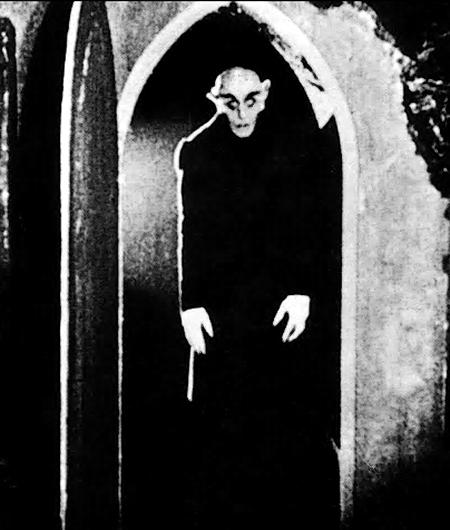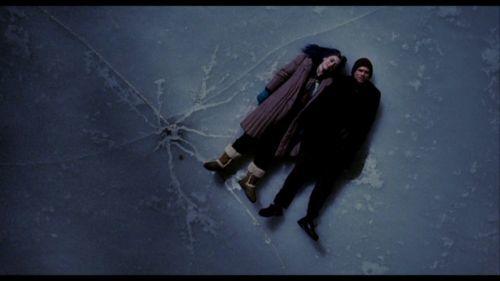I have left off of this list a great deal of old movies, some of my favorites, even, for the sake of making the list more accessible. Nothing bugs me more than clicking some Internet link that promises me the 10 BEST SCENES OF WHATEVER IN MOVIES EVAR!!! only to find that these movies are so esoteric that they've been seen by a grand total of twelve people worldwide.
I've chosen one old movie and a couple of foreign movies, but all-in-all, these should be fairly commonplace films. I haven't ranked them at all. They're all equally awesome shots in my eyes. I've gone on enough on purpose and reason and stuff, so here we go. (By the way, most of these images will get cut off on the right side due to Blogger's formatting. For your convenience, you can click any of the images for the full thing to load up in an otherwise blank page.)
#1: Jurassic Park
Steven Spielburg is not actually very high on my list of great directors, and Jurassic Park is not very high on my list of good movies, but there are a few shots present here that make me smile. Both come from the now-infamous T-Rex scene.
We discover that something is truly amiss when the glass of water on the dash that Dr. Ian Malcom has so recently demonstrated the Chaos Theory (in unfortunately brief and -- pardon the pun -- watered-down terminology) to Dr. Ellie Sattler (thanks, IMDb!) with begins quaking. Waves circle inward from the glass, and this may be the most suspenseful introduction to an action sequence ever filmed.
Not long after, they are driving in their Jurassic Park tour vehicle at break-neck speed away from Mr. Rex. The driver (Sam Neill? It's been awhile...) looks in the side view mirror to see a screaming dinosaur intent on eating them surprisingly close to the car. But to top it off, the mirror has that message that you don't see anymore etched across it: OBJECTS IN MIRROR ARE CLOSER THAN THEY APPEAR.

#2: Nosferatu
Max Schreck is absolutely terrifying in this silent film from 1922 that precious few people I know have seen. Nosferatu is the first vampire movie based around Bram Stoker's Dracula, and it's shots like the one below that creep me out even more than modern vampire movies with their special effects and enormous budgets.

The Dracula figure creeps up the stairwell. We have not seen him yet at this point in the film. This shot keeps his form a mystery from us, while hinting at its grotesquery. We can see his curved and sharpened nose, his menacing fingers outstretched in something resembling a strangulation gesture, his other arm pulled back offensively. Shadows encase the scene. This is truly one of the best horror films ever made, and it's shots like this that solidify it. Here is another, equally creepy shot, the reveal shot, when Nosferatu's offensive face is finally given to us.

#3: Eternal Sunshine of the Spotless Mind
Yes, I know this was used on the cover art of the DVD and movie posters for the movie, but there is a reason for that (finally). This is one of the most expressive camera angles I've ever seen.

The cracks in the ice discomfort us, not just because we know the danger involved in laying down on a frozen pond with a breaking top layer, but because we know by now that the relationship between Clementine and Joel is doomed for failure. The cracks show us that they are different, maybe too different to work things out, and yet they are encased by these faults, bound inexplicably together by them.
#4: Blade Runner
Granted, this is a movie that will probably end up on any "best of" list that I will ever put together, but this list is one it belongs on more than any other. This movie is almost entirely about the cinematography. The image here is from the opening shot, showing us a dystopian future view of Los Angeles.

The credits play out here, and we are whisked away to an interview between Leon and an administrator of the Voight-Kampff test where we are shown that replicants are identified by attributes of their eyes. Eyes are an important aspect of this film, and it follows that we should be presented with a great deal of eye shots. Ridley Scott doesn't disappoint. The film is brimming with such shots, images that make you believe that you're looking past the characters' appearance (appearance vs. reality is a major conflict of Blade Runner) and into their souls.
#5: Punch-Drunk Love
Another fantastic opening shot.

Barry Egan is a depressed loner with a penchant for trying to comprehend things which don't make sense to him. In this scene, he sits alone in the back of his warehouse, his desk full of clutter amongst such an expanse of emptiness, on the phone with a customer service representative for a pudding company trying to understand that they actually included and are ignoring a major loophole in a promotion they are running.
Some of the most beautiful imagery in the film comes after he falls in love with Lena, a stranger that may or may not be an attempt by one of Barry's seven sisters to hook him up with somebody.

His symmetry is found in the lovely Lena.
#6: Cache
Cache is a French film by a German director, Michael Haneke. It is a brilliantly made movie about guilt and shame. The title of the movie literally translates to "hidden." The opening credits pop up slowly in typewriter fashion over a very long shot of nothing happening. The text is tiny and difficult to read. The movie's title eventually pops up within crunched-together movie-making roles, but it's hard to see. The opening credits set the stage for a movie where you're constantly looking for clues in the immense clutter and the strange sense of order that comes from it. Here are two shots from the main character's home.


The bookshelves and media cabinets (what a horribly American term to describe a French film with) are so crammed that we strain to see titles on them, thinking that maybe one of them holds the secret to the mysterious stalker-esque video tapes that continue to appear on the main character's front porch. The crowds of people acting normal make everyone a suspect. The answer to this enigma does lie somewhere in the movie (or perhaps outside the movie; Haneke's a fan of breaking the fourth wall), but it truly is quite hidden.
#7: Funny Games (German)
I've selected the German version of Funny Games because I haven't seen the Noami Watts American version directed by the same German director who made the original as well as the previous movie on this list. Michael Haneke here breaks the fourth wall in showing us that we know how murders go and we know how these disgusting games are played because we see them in the movies all the time. In this particular shot, one of the central family's tormentors has killed the family dog and is now playing Hot and Cold with the mother to direct her to the dog's body. Of course, the mother doesn't know the dog's dead, and we as the audience haven't seen the dog die, nor heard it, nor borne any form of witness to the act, but, as the director suggests, we know how this game goes. To solidify this in our heads, the tormentor (whose name keeps changing throughout the film) turns, stares directly into the camera, and winks at the audience.

#8: One Hour Photo
One of my favorite thrillers in the past couple of decades involves Cy, a photograph developer for the local Wal-Mart style megastore. He develops the photographs of a seemingly happy suburban family and, in his lonely desperation, dreams of being a part of their family someday, an "Uncle" Cy the Photo Guy. Every frame of this movie is still. There is no movement of the camera. And each shot is perfectly framed, as if we are looking at an actual developed photograph. The shot that sticks out in my mind is one I could not find a screen capture of. Cy sits alone in a cheap and dirty restaurant with a scowl on his face as light pours through filthy bulbs onto his table. It's the very embodiment of loneliness and disgruntledness, and it fits the plot perfectly.



No comments:
Post a Comment